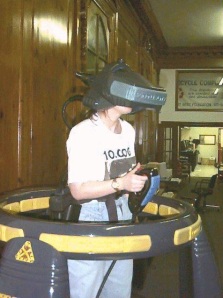 With the simmering success of the Occulus Rift, Sony’s announcement of their “Project Morpheus” device for the PS4 and persistent rumors that Microsoft is doing something similar for the XBox One this definitely seems to be the year when head-mounted VR will make its push into our living rooms. What people forget is that this is far from the first time that this has been promised.
With the simmering success of the Occulus Rift, Sony’s announcement of their “Project Morpheus” device for the PS4 and persistent rumors that Microsoft is doing something similar for the XBox One this definitely seems to be the year when head-mounted VR will make its push into our living rooms. What people forget is that this is far from the first time that this has been promised.
The image to the left is of my lovely bride (then girlfriend) nearly 20 years ago playing one of the first arcade-based VR units ever, the Virtuality 1000CS. It required you you mount up into a claustrophobic ring, wear a very heavy visor, an even heavier belt-pack and hold an enourmous controller.
I was volunteering at a local computer access facility in Boston called “Virtually Wired”. The organization, funded by local philanthropist Alex Randall, provided low-or-no-cost access to computers and the Internet via a motley collection of donated PCs and equipment. In the mid-to-late 90’s we were one of the few places that catered to the huge population of “Information Have Nots”.
In the beginning the business model was, let’s say, “fluid”. Some weird stuff happened as the owner tried to find its niche. One day two of these units showed up accompanied by our beaming benefactor looking like the cat that got the canary. They were an extremely odd addition to say the least and were literally the only pieces of “advanced” technology in the place. In the end they only stayed for a few days, but we did make sure that they were well exercised.
The units featured four games: Dactyl Nightmare, Grid Busters, Hero, and Legend Quest.While most of the games could be played with two players (since we had two units) the game to play was Dactyl Nightmare. It was a primitive arena death match featuring multiple weapons and open, multi-dimensional game play. It also featured a “wild” pterodactyl that would periodically descend to harass the players at random. It’s difficult to explain, but thankfully YouTube comes to rescue with a segment of the British show “Games Master” that features the game:
The experience was novel, there’s no denying that. It was also cumbersome, uncomfortable and vertigo inducing. The insanely low-resolution coupled with the anemic refresh rate also made it a very effective headache machine. Still, there was absolutely something to be said for running around in a maze and being able to literally look over your shoulder.
The systems were powered by beefed up Amiga 3000 personal computers with dual video cards and enhanced power-supplies. The PCs ran at a whopping 25 MHz and could be upgraded to an enormous 128 MB of RAM from their base of two MB via large expansion modules. These systems were actually older models at the time, the newer “2000 Series” versions leveraged a 486 PC, significantly enhanced graphics and upgraded games.
Physically the units were huge and at least 500-700 pounds each. The player stood on a raised platform, wore a heavy head-mounted display and an even heavier belt pack. Control was handled via the large thumbstick/trigger device. The whole arrangement took way too long to get into and out-of to make it viable as an arcade platform as one of these systems could easily run over $50,000. After much fanfare and promises of eventual low-cost home units the company faded away with a whimper a few years later.
Although we took many pictures with our very first digital camera, the Apple Quicktake 100, we unfortunately lost all but this one in a devastating hard drive crash in ’97. This one image of my adorable sweetie is the only actual evidence that we experienced, firsthand, the virtual reality revolution two decades ago.

I own 3 of these now.. check out Retro VR on Facebook
You must have significantly more room that we do. Still they gotta be a hell of a conversation piece! ;^)